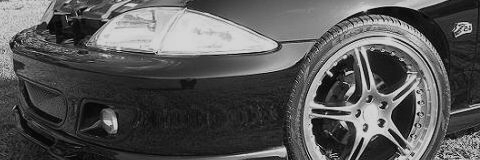Excidium, one of the critical things you are leaving out of your analysis in this thread and the other is pressure. I'll let the STS FAQ explain everything. It's already widely known that front mount turbo systems are more efficient than remote mount. Big friggin deal. Maximum efficiency was never the point of this type of system. The points I see behind the system are:
- Lower under hood temps
- Less chance of an oil line fire (again, less heat)
- Stealth look
- Crazy cool turbocharger exhaust sound (check out the vids on STS' website)
- No need for a turbo timer (since turbocharger temps are waaay less than under hood)
- Efficiency through charge piping (less of a need for an intercooler)
- Easier to install (less of a confined area to work in)
- It's unique!!!!
All of the questions in this thread and more have been answered by STS in their FAQ:
If water hits the hot turbo, will it crack?
Seems like it might when you first think about it, however, when I asked the Garrett engineers this questions they just laughed.
There is a big difference in water splashing on a hot turbo and submerging it in enough water and fast enough to really cool it down fast. Both the new turbocharged Vette systems and the new Porsche systems sit the turbo down low and exposed to water and anything else that goes under a car.
Plus, our turbos just don't get that hot and when weather conditions are such that there is a lot of water around, you can't push enough boost to get the turbo hot anyway because you'd just spin the tires.
Doesn't heat create the velocity in the exhaust gasses to spool the turbo?
No, heat doesn't create velocity. Heat creates
volume. If you look at any of the physics laws for gasses, you will find that pressure and volume and heat are related. PV=NRT is a popular one, The V isn't for velocity, it is for Volume.
The turbine housing is what creates the velocity. The scrolling design that reduces the volume of the exhaust chamber as it scrolls around causes the gasses to have to increase in velocity and pressure to maintain the same flow rate.
Hotter gasses have more volume, thus requiring a higher A/R which in effect means that it starts at say 3" and scrolls down to approximately 1". Lower temperature gasses are denser and have less volume, so they require a lower A/R housing which would start at the same 3" volume, as the turbine housings use standard flanges, and scroll down to say 3/4".
Now if you were to reverse the housings in application, the conventional turbo would spool up extremely quick, at say around 1500 rpm but would cause too much backpressure at higher rpms because the higher volume of gas couldn't squeeze through the 3/4" hole without requiring a lot of pressure to force it through. On the reverse side, the remote mounted turbo with its cooler denser gasses, wouldn't spool up till say around 4000 rpms but once spooled up would make efficient power because it doesn't require hardly any backpressure to push the lower volume of gas through the larger 1" hole.
Isn't there a huge pressure drop with such long intake tubes?
No, if the pipes were 100' long there would be but we are only talking a few extra feet and we size the charge air tubing so that it will flow without a large pressure drop. We typically will get about 1/4 to 3/4 lb difference between the turbo compressor and the intake manifold, which is nothing compared to the pressure drop across an intercooler. With high boost applications, these numbers will increase slightly.
Don't turbos have to be really hot to work properly?
Putting a torch to your turbo and getting it hot doesn't produce boost. What produces boost is airflow across the turbine which causes the turbine to spin. If turbochargers required very high temperatures to produce boost, Diesel trucks and Methanol Race cars wouldn't be able to run turbos. However, each of these "Low Exhaust Temperature" vehicles work very well with turbochargers when, like any turbo application, the turbocharger is sized correctly.
In a conventional, exhaust manifold mounted turbocharger system, the extra heat causes the air molecules to separate and the gas becomes "thinner" because of the extra space between the molecules. This extra space increases the volume of air but doesn't increase the mass of the air. Because the volume is higher, the velocity of the gas has to be higher to get it out in the same amount of time.
By mounting the turbo further downstream, the gasses do lose heat energy and velocity, however, there is just as much mass (the amount of air) coming out of the tailpipe as there is coming out of the heads. So you are driving the turbine with a "denser" gas charge.
The same number of molecules per second are striking the turbine and flowing across the turbine at 1200F as there is at 1700F.
Front mounted turbos typically run an A/R ratio turbine housing about 2 sizes larger because the velocity is already in the gasses and the volume is so big that the turbine housing must be larger to not cause a major restriction in the exhaust system which would cause more backpressure. With the remote mounted turbo, the gasses have condensed and the volume is less, so a smaller A/R ratio turbine housing can be used which increases the velocity of the gasses while not causing any extra backpressure because the gas volume is smaller and denser.
Sizing is everything with turbos. There is more to sizing a turbo for an application than cubic inches, Volumetric Efficiency, and RPM ranges. A turbo must also be sized for the exhaust temperatures. A turbine housing sized for 1700F gasses would have lag if the gasses were 1200F. This is why turbo cars have lag when they are cold and not warmed up yet. Both systems work well if sized correctly.
Shamelessly jacked from STS:
http://www.ststurbo.com/f_a_q










